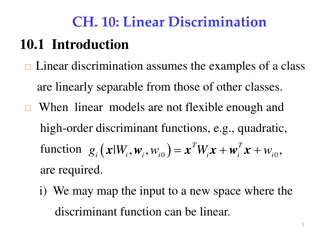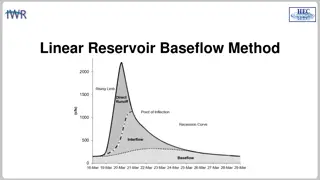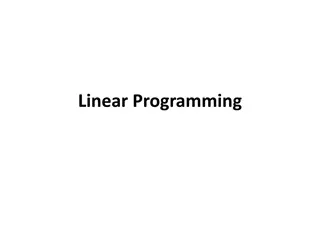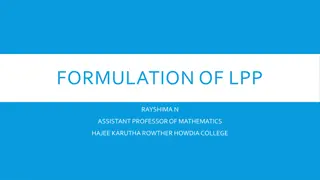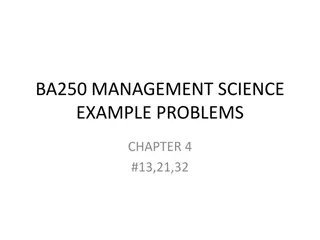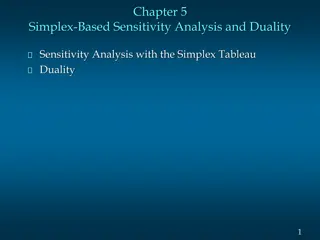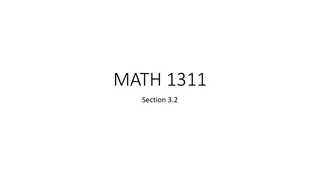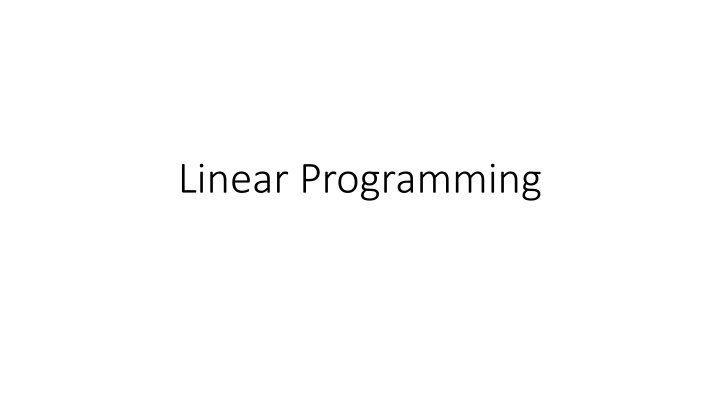
Optimizing Production for Wyndor Glass Co.
Wyndor Glass Co. is revamping its product line to focus on two new profitable products. By maximizing total profit through a linear programming model, the company aims to determine the ideal production rates for each product while considering limited production capacities across its three plants. Data collection and analysis play a crucial role in formulating and solving this optimization problem.
Download Presentation

Please find below an Image/Link to download the presentation.
The content on the website is provided AS IS for your information and personal use only. It may not be sold, licensed, or shared on other websites without obtaining consent from the author. If you encounter any issues during the download, it is possible that the publisher has removed the file from their server.
You are allowed to download the files provided on this website for personal or commercial use, subject to the condition that they are used lawfully. All files are the property of their respective owners.
The content on the website is provided AS IS for your information and personal use only. It may not be sold, licensed, or shared on other websites without obtaining consent from the author.
E N D
Presentation Transcript
Applications The WYNDOR GLASS CO. produces high-quality glass products, including windows and glass doors. It has three plants. Aluminum frames and hardware are made in Plant 1, wood frames are made in Plant 2, and Plant 3 produces the glass and assembles the products. Because of declining earnings, top management has decided to revamp the company s product line. Unprofitable products are being discontinued, releasing production capacity to launch two new products having large sales potential: Product 1: An 8-foot glass door with aluminum framing Product 2: A 4 x 6 foot double-hung wood-framed window Product 1 requires some of the production capacity in Plants 1 and 3, but none in Plant 2. Product 2 needs only Plants 2 and 3. The marketing division has concluded that the company could sell as much of either product as could be produced by these plants. However, because both products would be competing for the same production capacity in Plant 3, it is not clear which mix of the two products would be most profitable. Therefore, an OR team has been formed to study this question. Determine what the production rates should be for the two products in order to maximize their total profit, subject to the restrictions imposed by the limited production capacities available in the three plants. (Each product will be produced in batches of 20, so the production rate is defined as the number of batches produced per week.) Any combination of production rates that satisfies these restrictions is permitted, including producing none of one product and as much as possible of the other.
Data Needed The OR team also identified the data that needed to be gathered: 1. Number of hours of production time available per week in each plant for these new products. (Most of the time in these plants already is committed to current products, so the available capacity for the new products is quite limited.) 2. Number of hours of production time used in each plant for each batch produced of each new product. 3. Profit per batch produced of each new product. (Profit per batch produced was chosen as an appropriate measure after the team concluded that the incremental profit from each additional batch produced would be roughly constant regardless of the total number of batches produced. Because no substantial costs will be incurred to initiate the production and marketing of these new products, the total profit from each one is approximately this profit per batch produced times the number of batches produced.)
Data collection Obtaining reasonable estimates of these quantities required enlisting the help of key personnel in various units of the company. Staff in the manufacturing division provided the data in the first category above. Developing estimates for the second category of data required some analysis by the manufacturing engineers involved in designing the production processes for the new products. By analyzing cost data from these same engineers and the marketing division, along with a pricing decision from the marketing division, the accounting department developed estimates for the third category. The OR team immediately recognized that this was a linear programming problem of the classic product mix type, and the team next undertook the formulation of the corresponding mathematical model.
Formulating the model x1 = number of batches of product 1 produced per week x2 = number of batches of product 2 produced per week Z = total profit per week (thousands of dollars) from producing these two products From bottom row of Table 3.1 ? = 3 ?1+ 5?2
Constraints (see Table 3.1) ?1 4 2?2 12 3?1+ 2?2 18 ?1 0 ?2 0 Classic example of resource-allocation problem Most common type of linear programming problem
Flair Furniture Company The Flair Furniture Company produces inexpensive tables and chairs. The production process for each is similar in that both require a certain number of hours of carpentry work and a certain number of labor hours in the painting and varnishing department. Each table takes 4 hours of carpentry and 2 hours in the painting and varnishing shop. Each chair requires 3 hours in carpentry and 1 hour in painting and varnishing. During the current production period, 240 hours of carpentry time are available, and 100 hours in painting and varnishing time are available. Each table sold yields a profit of $70; each chair produced is sold for a $50 profit. Flair Furniture s problem is to determine the best possible combination of tables and chairs to manufacture in order to reach the maximum profit. The firm would like this production mix situation formulated as an LP problem. We begin by summarizing the information needed to formulate and solve this problem. Next, we identify the objective and the constraints. The objective is Maximize profit.
The constraints are 1. The hours of carpentry time used cannot exceed 240 hours per week. 2. The hours of painting and varnishing time used cannot exceed 100 hours per week. The decision variables that represent the actual decisions we will make are defined as T = number of tables to be produced per week C = number of chairs to be produced per week Now we can create the LP objective function in terms of T and C. The objective function is Maximize profit = $70T + $50C
Our next step is to develop mathematical relationships to describe the two constraints in this problem. One general relationship is that the amount of a resource used is to be less than or equal to (<=) the amount of the resource available. So the first constraint may be stated as follows: Carpentry time used <= Carpentry time available 4T + 3C <= 240 (hours of carpentry time) Similarly, the second constraint is as follows: 2 T + 1C <= 100 (hours of painting and varnishing time) The complete problem may now be restated mathematically as Maximize profit = $70T + $50C subject to the constraints 4T + 3C <= 240 (carpentry constraint) 2T + 1C <= 100 (painting and varnishing constraint) T >= 0 (first nonnegativity constraint) C >= 0 (second nonnegativity constraint)
The Electrocomp Corporation manufactures two electrical products: air conditioners and large fans. The assembly process for each is similar in that both require a certain amount of wiring and drilling. Each air conditioner takes 3 hours of wiring and 2 hours of drilling. Each fan must go through 2 hours of wiring and 1 hour of drilling. During the next production period, 240 hours of wiring time are available, and up to 140 hours of drilling time may be used. Each air conditioner sold yields a profit of $25. Each fan assembled may be sold for a $15 profit. Formulate and solve this LP production mix situation to find the best combination of air conditioners and fans that yields the highest profit. Use the corner point graphical approach.
Minimization problem The Holiday Meal Turkey Ranch is considering buying two different brands of turkey feed and blending them to provide a good, low-cost diet for its turkeys. Each feed contains, in varying proportions, some or all of the three nutritional ingredients essential for fattening turkeys. Each pound of brand 1 purchased, for example, contains 5 ounces of ingredient A, 4 ounces of ingredient B, and 0.5 ounce of ingredient C. Each pound of brand 2 contains 10 ounces of ingredient A, 3 ounces of ingredient B, but no ingredient C. The brand 1 feed costs the ranch 2 cents a pound, while the brand 2 feed costs 3 cents a pound. The owner of the ranch would like to use LP to determine the lowest-cost diet that meets the minimum monthly intake requirement for each nutritional ingredient. MINIMUM MONTHLY REQUIREMENT PER Turkey for ingredient A is 90 ounce, for B is 48 ounce and for ingredient C is 1.5 ounce.
A candidate for mayor in a small town has allocated $40,000 for last- minute advertising in the days preceding the election. Two types of ads will be used: radio and television. Each radio ad costs $200 and reaches an estimated 3,000 people. Each television ad costs $500 and reaches an estimated 7,000 people. In planning the advertising campaign, the campaign manager would like to reach as many people as possible, but she has stipulated that at least 10 ads of each type must be used. Also, the number of radio ads must be at least as great as the number of television ads. How many ads of each type should be used? How many people will this reach?
The dean of the Western College of Business must plan the schools course offerings for the fall semester. Student demands make it necessary to offer at least 30 undergraduate and 20 graduate courses in the term. Faculty contracts also dictate that at least 60 courses be offered in total. Each undergraduate course taught costs the college an average of $2,500 in faculty wages, and each graduate course costs $3,000. How many undergraduate and graduate courses should be taught in the fall so that total faculty salaries are kept to a minimum?
A winner of the Texas Lotto has decided to invest $50,000 per year in the stock market. Under consideration are stocks for a petrochemical firm and a public utility. Although a long-range goal is to get the highest possible return, some consideration is given to the risk involved with the stocks. A risk index on a scale of 1 10 (with 10 being the most risky) is assigned to each of the two stocks. The total risk of the portfolio is found by multiplying the risk of each stock by the dollars invested in that stock. The following table provides a summary of the return and risk: STOCK ESTIMATED RETURN RISK INDEX Petrochemical 12% 9 Utility 6% 4 The investor would like to maximize the return on the investment, but the average risk index of the investment should not be higher than 6. How much should be invested in each stock? What is the average risk for this investment? What is the estimated return for this investment?

